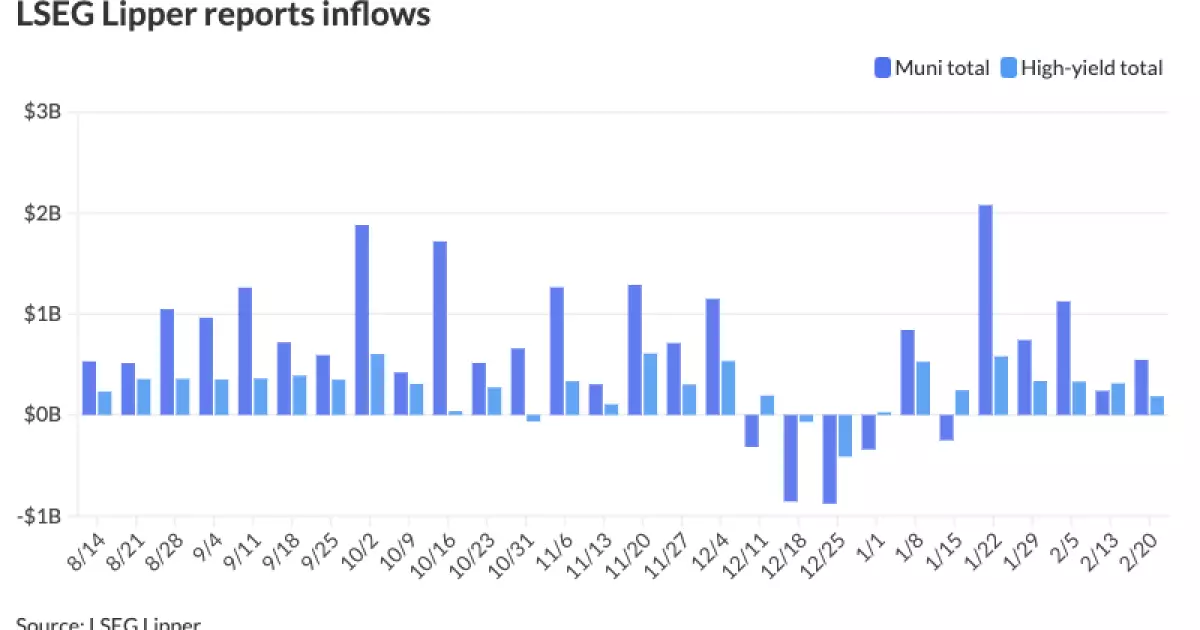The landscape of municipal bonds is ever-evolving, influenced by economic conditions, market demand, and the ongoing dynamics in the domestic financial ecosystem. Recently, the sector has shown signs of resilience despite notable fluctuations in Treasury yields and stock market performance. As analysts interpret these movements, a comprehensive view of the municipal bond market suggests both opportunities and challenges for investors navigating these waters.
On Thursday, the municipal bond market demonstrated a steady trend, showing slight firmer movements as a significant $2.5 billion offering for the Brightline West Passenger Rail Project was priced. This occurred in the context of a quieter atmosphere in new issuances, hinting at potential investor caution or market processes at play. The reduction in U.S. Treasury yields paired with a decline in equity values may suggest a flight to safety, with municipal bonds becoming an appealing option for risk-averse investors.
The ratios of municipalities to U.S. Treasury (UST) bonds provide insight into pricing dynamics, with the two-year ratio at 62%, the five-year at 63%, the 10-year at 67%, and the 30-year at 85%. Such ratios indicate the relative appeal of municipal bonds compared to their Treasury counterparts, showcasing varying investor sentiment along the maturity curve.
Despite volatility earlier in the year, where tariff-induced inflation concerns pushed the 10-year UST yield briefly to 4.80%, the interest rates closed lower, adjusting to a new economic narrative. According to James Pruskowski, chief investment officer at 16Rock Asset Management, the recent changes in the economic framework—such as the rise of innovative platforms like Deepseek in the AI sector and smoother cabinet hearings—played a crucial role in stabilizing sentiment. In turn, these developments are expected to influence the expectations surrounding interest rates over the coming months.
Moving into February, the consensus suggests the market will continue to exhibit volatility; however, the rates are anticipated to remain within a confined range, accompanied by significant inflows into municipal funds. These inflows reflect investor confidence and indicate a robust interest in the asset class, even amid turbulent conditions—a positive sign for the municipal bond sector.
Upcoming weeks appear promising for the tax-exempt bond market, particularly with the influx of mid-month reinvestment capital of approximately $18 billion. However, new issue supply remains slightly restrained, totaling only $4.3 billion during a shortened holiday week. The reduced supply points to a fertile environment for bond prices to firm up, particularly as investor demand increases.
Strategists at J.P. Morgan highlight that the speaking conditions in the primary issuance pipeline remain strong. Yet, the challenge lies in sourcing specific exposures amid accelerating fund flows, indicating a potential disconnect between supply and targeted investor appetite. It remains critical for managers to navigate these challenges strategically to maintain exposure to competitive sectors.
Long-dated high-grade municipal bonds are witnessing yields close to yearly highs, a significant point when contrasted against UST rates resting at three-year highs. These absolute yields appear attractive for borrowers, particularly when factoring in long-term projections that indicate lower rates by 2025. This scenario presents a valuable opportunity for investors considering the historical context of bond pricing.
Recent primary market actions reveal continued activity with institutions leveraging the favorable conditions. For instance, Morgan Stanley’s pricing of $2 billion in green revenue bonds for the Brightline West project indicates a marked interest in sustainable infrastructure investment, aligning with broader trends in the bond markets focused on environmental responsibility.
Recent statistics showed a significant uptick in municipal bond fund flows, with a return of $546.3 million in the week ending Wednesday and an increase in high-yield fund inflows. This momentum illustrates the growing favoritism towards tax-exempt instruments as investors reevaluate their portfolios amid fluctuating market conditions. However, the drop in tax-exempt money market assets underlines a cautious approach as investors opt for riskier, higher-return alternatives.
As the bond markets navigate through upcoming months, the interplay between yields, inflation expectations, and municipal supply will remain pivotal. Observers anticipate that while current favorable conditions may persist, challenges will arise as reinvestment capital diminishes and demands shift towards more diversified strategies.
The municipal bond market remains a significant player in the macroeconomic landscape, combining steady issuance opportunities with strategic investor behaviors. Maintaining awareness of these evolving patterns will be essential for navigating potential risks and capitalizing on emerging opportunities within this critical segment of the financial markets.


Leave a Reply